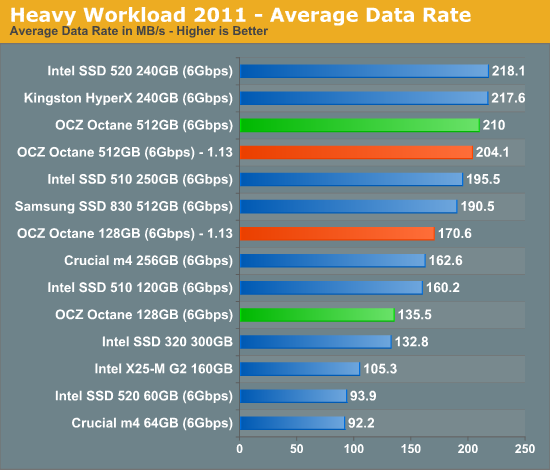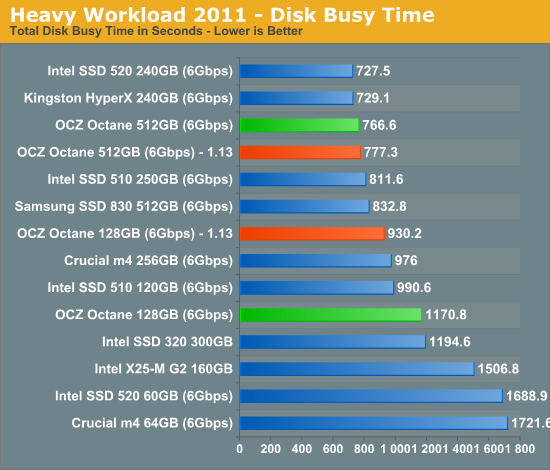OCZ Octane 1.13 Firmware Update: Improving 4KB Random Write Performance
by Anand Lal Shimpi on February 9, 2012 11:21 PM ESTAnandTech Storage Bench 2011
Last year we introduced our AnandTech Storage Bench, a suite of benchmarks that took traces of real OS/application usage and played them back in a repeatable manner. I assembled the traces myself out of frustration with the majority of what we have today in terms of SSD benchmarks.
Although the AnandTech Storage Bench tests did a good job of characterizing SSD performance, they weren't stressful enough. All of the tests performed less than 10GB of reads/writes and typically involved only 4GB of writes specifically. That's not even enough exceed the spare area on most SSDs. Most canned SSD benchmarks don't even come close to writing a single gigabyte of data, but that doesn't mean that simply writing 4GB is acceptable.
Originally I kept the benchmarks short enough that they wouldn't be a burden to run (~30 minutes) but long enough that they were representative of what a power user might do with their system.
Not too long ago I tweeted that I had created what I referred to as the Mother of All SSD Benchmarks (MOASB). Rather than only writing 4GB of data to the drive, this benchmark writes 106.32GB. It's the load you'd put on a drive after nearly two weeks of constant usage. And it takes a *long* time to run.
1) The MOASB, officially called AnandTech Storage Bench 2011 - Heavy Workload, mainly focuses on the times when your I/O activity is the highest. There is a lot of downloading and application installing that happens during the course of this test. My thinking was that it's during application installs, file copies, downloading and multitasking with all of this that you can really notice performance differences between drives.
2) I tried to cover as many bases as possible with the software I incorporated into this test. There's a lot of photo editing in Photoshop, HTML editing in Dreamweaver, web browsing, game playing/level loading (Starcraft II & WoW are both a part of the test) as well as general use stuff (application installing, virus scanning). I included a large amount of email downloading, document creation and editing as well. To top it all off I even use Visual Studio 2008 to build Chromium during the test.
The test has 2,168,893 read operations and 1,783,447 write operations. The IO breakdown is as follows:
| AnandTech Storage Bench 2011 - Heavy Workload IO Breakdown | ||||
| IO Size | % of Total | |||
| 4KB | 28% | |||
| 16KB | 10% | |||
| 32KB | 10% | |||
| 64KB | 4% | |||
Only 42% of all operations are sequential, the rest range from pseudo to fully random (with most falling in the pseudo-random category). Average queue depth is 4.625 IOs, with 59% of operations taking place in an IO queue of 1.
Many of you have asked for a better way to really characterize performance. Simply looking at IOPS doesn't really say much. As a result I'm going to be presenting Storage Bench 2011 data in a slightly different way. We'll have performance represented as Average MB/s, with higher numbers being better. At the same time I'll be reporting how long the SSD was busy while running this test. These disk busy graphs will show you exactly how much time was shaved off by using a faster drive vs. a slower one during the course of this test. Finally, I will also break out performance into reads, writes and combined. The reason I do this is to help balance out the fact that this test is unusually write intensive, which can often hide the benefits of a drive with good read performance.
There's also a new light workload for 2011. This is a far more reasonable, typical every day use case benchmark. Lots of web browsing, photo editing (but with a greater focus on photo consumption), video playback as well as some application installs and gaming. This test isn't nearly as write intensive as the MOASB but it's still multiple times more write intensive than what we were running last year.
As always I don't believe that these two benchmarks alone are enough to characterize the performance of a drive, but hopefully along with the rest of our tests they will help provide a better idea.
The testbed for Storage Bench 2011 has changed as well. We're now using a Sandy Bridge platform with full 6Gbps support for these tests.
AnandTech Storage Bench 2011 - Heavy Workload
We'll start out by looking at average data rate throughout our new heavy workload test:

The good news is that overall performance is mostly unaffected. The 512GB drive took a little drop while the 128GB drive actually saw overall performance increase.
The next chart represent sthe same data, but in a different manner. Instead of looking at average data rate, we're looking at how long the disk was busy for during this entire test. Note that disk busy time excludes any and all idles, this is just how long the SSD was busy doing something:











23 Comments
View All Comments
darckhart - Friday, February 10, 2012 - link
hm i thought the octane's used intel's 25nm synchronous mlc nand. the samsung uses some special concoction cooked up by themselves and toshiba.ckryan - Friday, February 10, 2012 - link
Yes. Samsung and Toshiba both make Toggle NAND, but I don't think they're all that similar. Samsung and Toshiba both have their own fabs (Toshiba in Japan, Samsung in Korea) and I would assume they put better NAND in their own drives (at least, this is what Intel supposedly does). Therefore, arguably, you could get better NAND in the 830.I don't know why so few drives utilize Samsung NAND today. Toshiba NAND must be much cheaper or something. I have a couple older drives with Samsung MLC and SLC, but I can't recall any modern drive using their stuff (beside Samsung of course).
landion - Friday, February 10, 2012 - link
Are they going to release a similar firmware update for the Octane S2?Does the S2 have the same problem that prompted the update for the octane?
MrSpadge - Friday, February 10, 2012 - link
It was not a problem, it was rebalancing performance. If the S2 performs the same as the regular one, it would benefit & loose the same way.celestialgrave - Friday, February 10, 2012 - link
Was there any difference in the power usage since the performance changed?SlyNine - Friday, February 10, 2012 - link
So quick quetsion (and I know this isn't the best place to ask) But Intels new toolbox is telling me to upgrade my G2's. But I'm currently running Windows off of them and have them in a RIAD 0. Anyone know if thats ok to upgrade the firmware while operating the OS from them?sanguy - Friday, February 10, 2012 - link
OCZ has lost it's unique (and some say unfair) advantage with SandForce so it is zero surprise they are working on Everest as the go-forward platform.Intel's recent 520 release is a perfect example of this - the only thing keeping it from completely making OCZ SF drives irrelevant in the market is price. And this is Intel's way - why give it away when you have customers lining up to pay the premium for quality? When that line up gets short, the price will be adjusted and Intel will dominate the SF drive market.
So the question is - can OCZ compete on performance, features, and price? I'd say in the long run it can't.
RU482 - Friday, February 10, 2012 - link
more OCZ beta testing...I mean updates for the customer to performCoup27 - Friday, February 10, 2012 - link
But only if it is not your boot drive. As there is inexplicably no linux update method, you have to dig out a second ssd/hdd and install your OS onto that and then connect the Octane as a secondary drive, obviously making sure your SATA port numbers are all rosey and you haven't installed Intel RST.And if you own a laptop you're f****d.
Seriously, WTF??!!
Jokeshop.
sanguy - Friday, February 10, 2012 - link
Will be interesting to see OCZ's blame game tactics now.They used to be very quick to blame the 3rd party controller manufacture, but that excuse train has dried up.
If firmware, tools, etc, are buggy it's one throat to choke -- and that's OCZ's throat. Nobody else.
God help the OCZ customers.